2 Carpal Fractures
There are eight carpal bones at the wrist, situated between the radius and ulna in the forearm and the metacarpals in the hand. The most common (and important) carpal fracture is that of the scaphoid (discussed in its own Chapter). Among the other carpal bones, only the triquetrum, hamate and pisiform are likely to be fractured in isolation; other carpal fractures are seen more commonly in conjunction with other injuries. Most isolated carpal fractures are caused by direct trauma.
Structure and function
There are eight carpal bones, each with its own unique shape and size. The carpal bones articulate with the radius and ulna proximally and the 5 metacarpal joints distally.
There are eight carpal bones arranged in two rows: the proximal row consists of the scaphoid, lunate, triquetrum and pisiform. The distal row consists of the trapezium, trapezoid, capitate and hamate. The proximal row articulates with the distal radius and distal row connects to the metacarpal bones of the hand.
Proximal Row
The scaphoid (Figure 1) is located on the radial side of the proximal carpal row.

The scaphoid articulates with 4 other carpal bones and is involved with most carpal motions, especially flexion. The vascular supply of this bone travels from the distal region of the scaphoid back proximally (a so-called “retrograde flow”). Ossification in children also occurs in the distal-to-proximal direction.
The lunate (Figure 2) is half-moon shaped and is positioned between the scaphoid and the triquetrum.
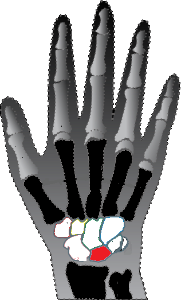
The lunate is important in flexion/extension and radial/ulnar deviation at the radiocarpal and midcarpal joints.
The triquetrum (Figure 3) is located on the ulnar side of the proximal carpal row. It is pyramid-shaped with an oval shaped facet on its volar side.
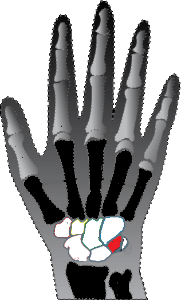
The triquetrum articulates with the pisiform on the volar side, the lunate laterally and the triangular fibrocartilage complex proximally.
The pisiform (Figure 4) is a pea shaped sesamoid bone that articulates with the triquetrum.
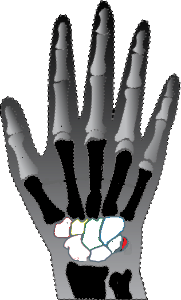
The pisiform is enclosed in the sheath of the flexor carpi ulnaris tendon and is in close proximity to the ulnar nerve.
Distal row
The hamate (Figure 5) is a wedge-shaped bone on the ulnar side of the distal carpal row.
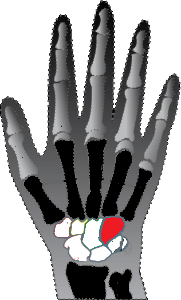
On the distal volar surface, a hook protrudes out from the ulnar side of the bone. The hamate serves as an attachment site for many ligaments, including the transverse carpal ligament atop the carpal tunnel. The hook of the hamate acts as a pulley for the 4th and 5th finger flexor tendons.
The capitate (Figure 6) is the largest carpal bone and is positioned in the central column of the wrist.
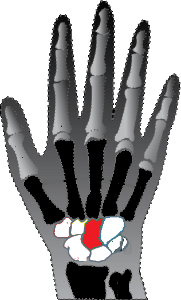
The capitate articulates with the scaphoid, lunate, hamate and trapezoid, as well as the 2nd, 3rd and 4th metacarpals.
The trapezium (Figure 7) is a quadrangular shaped bone located on the radial side of the distal carpal row.
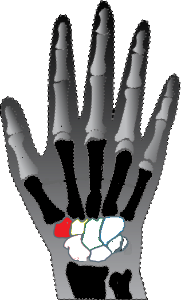
The trapezium has a double-saddle facet that articulates with the 1st metacarpal allowing both flexion/extension, abduction/adduction, circumduction and opposition at the joint.
The trapezoid (Figure 8) is positioned between the capitate and trapezium.

Patient presentation
Patients with acute carpal fractures will typically present with wrist pain and swelling and there will be point tenderness near the fracture. Due to the close proximity of some carpal bones to nearby nerves, some carpal fractures will be associated with neurological injury as well.
Triquetral fractures are usually a result of a direct blow to the dorsum of the hand or a fall, forcing the wrist into extreme extension and ulnar deviation. This position can cause the proximal hamate and distal radius to impinge on the triquetrum and sheer it. Patients typically present with pain and swelling in the wrist with increased tenderness on the ulnar side. The triquetrum lies deep to the pisiform bone, making it difficult to palpate on exam. To expose the bone on exam, the hand must be placed into a position of radial deviation.
Hamate fractures are associated with racket sports or sports involving clubs. The injury is often to the hook of the hamate, sparing the body. Patients will usually have history of a trauma, for example, the accidental strike of the ground with a golf swing. They will have ulnar sided wrist pain, pain in the hypothenar region and decreased grip strength. Because this injury is associated with compression of the ulnar nerve as it crosses Guyon’s canal in the wrist, patients may have paresthesias in their ring and small fingers, with weakness of the intrinsic muscles supplied by the ulnar nerve. Patients may also have pain with resisted flexion of the 4th and 5th finger. Hamate body fractures are typically seen in injuries where an axial force was applied to a closed fist. Patients will similarly complain of ulnar sided wrist pain and present with swelling.
Pisiform fractures are usually caused by a fall on the outstretched hand. The chief complaint is ulnar sided wrist pain and the physical exam is notable for point tenderness over the pisiform.
Trapezoid and trapezium fractures are usually not caused by direct trauma, but by a so-called “nutcracker effect,” namely, pressure from the second metacarpal when the finger and wrist are hyper-extended. An index finger injury with tenderness more proximally, towards the wrist, should increase the suspicion of this (rare) fracture.
“Fractures” of the lunate seen on x-ray, especially without a history of specific injury, are more likely to represent fragmentation of the bone from osteonecrosis (Kienböck’s disease).
Capitate fractures in isolation are rare. A ligament injury should be suspected and ruled out when this diagnosis is made (or considered).
Note that many carpal fractures may present as sub-acute or chronic diffuse pain, due to missed diagnosis of a prior injury. In those settings, the presentation is similar to carpometacarpal or radiocarpal arthritis or tendinitis.
Objective evidence
The standard wrist radiographs ordered for assessment of the carpal bones include AP, lateral and oblique views. Disruption or widening of the spaces between the bones may indicate carpal instability or damage to the ligaments.
CT scan is the preferred study for diagnosis of hook of hamate fractures (as shown in Figure 9).

MRI can be a useful modality in not only detecting occult fractures, but also detecting soft tissue injuries such as ligaments or tendon damage.
Interpretation of carpal radiographs is admittedly difficult for the novice, and there is no shame in asking an expert for help. Two things must be kept in mind: 1) dislocations require urgent attention and 2) the wrist should be immobilized until a definitive diagnosis is obtained.
Epidemiology
Carpal fractures make up nearly one-quarter of hand fractures and about 5% of all fractures. This estimate likely under-represents the true incidence of carpal fractures, as many are presumably not formally diagnosed (and dismissed by the unsuspecting patient as a contusion). As noted, scaphoid fractures account for a majority of carpal bone fractures. The second most common carpal fracture is of the triquetrum, which accounts for 14% of all wrist injuries.
Differential diagnosis
All wrist pain due to falls on an outstretched hand should be carefully assessed for the possibility of a carpal fracture. In particular, scaphoid fracture should be kept in mind, due to the high risk of developing a non-union and, ultimately, osteonecrosis and post traumatic arthritis if left untreated.
Injuries to the radioulnar joint should also be ruled out when considering carpal fractures.
Carpal dislocations can occur commonly in conjunction with carpal fractures.
Fractures of some carpal bones usually occur in conjunction with other carpal fractures, making it important to rule out fractures to adjacent carpal bones.
Red flags
Marked tenderness over the scaphoid tubercle or the anatomic snuffbox in the setting of normal x-rays suggests a non-displaced scaphoid fracture (which must be immobilized).
Finger injuries with wrist tenderness suggest an injury to the carpal bones.
Treatment options and outcomes
The treatment of carpal fractures aims primarily to restore pain-free motion of the wrist. An important secondary aim is to reduce the patient’s risk of developing osteoarthritis of the carpal bones.
Most stable, non-displaced fractures of carpal bones are treated with casting for 6-8 weeks. Non-displaced scaphoid fractures should be immobilized in a thumb spica cast. In cases of displacement or instability, open reduction with internal fixation is considered.
Most isolated carpal fractures (except the scaphoid, which has a more tenuous blood supply) heal uneventfully. Because there may be an associated ligament injury with subtle instability, osteoarthritis may develop even if the fractures do heal nicely.
Risk factors and prevention
The use of wrist guards when rollerblading (or when participating in any other activity with a high rate of falls on the outstretched hand) may be helpful.
Miscellany
The mnemonic for recalling the names of the carpal bones in medial-to-lateral order, “Some Lovers Try Positions That They Can’t Handle,” is somewhat self-referential as weight-bearing on the palm is painful for people with injured or arthritic carpal bones. (ed: The vivacity of the mental image is worth the risk of offending the Bluenose readers).
Key terms
anatomic snuffbox; carpal fracture; osteoecrosis; non-union; Scaphoid; Lunate; Triquetrum; Pisiform; Trapezium; Trapezoid; Capitate; Hamate
Skills
Recognize and name a carpal fracture; perform a physical exam to detect and define carpal injury.
